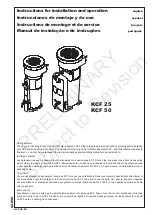
MAINTENANCE /
REP
AIR
TROUBLESHOOTING
OPERA
TION
ASSEMBL
Y /
INST
ALLA
TION
SAFETY /
SPECIFICA
TIONS
GETTING
ST
AR
TED
12
TROUBLESHOOTING GUIDE
SYMPTOM
POSSIBLE CAUSE(S)
CORRECTIVE ACTION
Low discharge pressure
1. Air demand exceeds pump capacity
1. Reduce air demand or use a compressor with more
capacity.
2. Air leaks
2. Listen for escaping air. Apply soap solution to all
fittings and connections. Bubbles will appear at
points of leakage.Tighten or replace leaking fittings
or connections.
3. Restricted air intake
3. Clean the air filter element.
4. Blown gaskets
4. Replace any gaskets proven faulty on inspection.
5. Leaking or damaged valves
5. Remove head and inspect for valve breakage,
misaligned valves, damaged valve seats, etc. Replace
defective parts and reassemble.
Install a new head gasket
each time the head is removed
Pump overheating causes air
filter to melt
1.
Insulating gasket between filter
and head is missing
1. Install
gasket.
2. Broken valves/blown gasket
2. Replace valves or install new gasket.
Excessive noise (knocking)
1. Loose motor or compressor pulley
1. Loose motor or compressor pulleys are a very
common cause of compressors knocking. Tighten
pulley clamp bolts and set-screws.
2. Lack of oil in crankcase
2. Check for proper oil level; if low, check for possible
damage to bearings. Dirty oil can cause excessive
wear.
3. Worn connecting rod
3. Replace connecting rod. Maintain oil level and
change oil more frequently.
4. Worn piston pin bores
4. Remove piston assemblies from the compressor and
inspect for excess wear. Replace excessively worn
piston pin or pistons, as required. Maintain oil level
and change oil more frequently.
5. Piston hitting the valve plate
5. Remove the compressor head and valve plate
and inspect for carbon deposits or other foreign
matter on top of piston. Replace head and valve
plate using new gasket. See Lubrication section for
recommended oil
6. Noisy check valve in compressor
system
6. Replace.
Do not disassemble check valve
with air pressure in tank
Large quantity of oil in the
discharge air
NOTE:
In an oil lubricated
compressor there will always
be a small amount of oil in the
air stream.
1. Worn piston rings
1. Replace with new rings. Maintain oil level and
change oil more frequently.
2. Compressor air intake restricted
2. Clean filter. Check for other restrictions in the
intake system.
3. Excessive oil in compressor
3. Drain down to full level.
4. Wrong oil viscosity
4. Use Mobil 1
®
10W-30
Water in discharge air/tank
1. Normal operation. The amount of
water increases with humid weather
1. Drain tank more often. At least daily.
2. Add a filter to reduce the amount of water in the
air line.
Motor hums and runs slowly or
not at all
1. Use of extension cord
1. Do not use an extension cord. Use longer air hose
with larger diameter.
2. Malfunctioning check valve or
unloader valve
2. Replace check valve, unloader valve or pressure
switch.
Do not disassemble check valve
with air pressure in tank
3. Low voltage
3. Check with volt meter, check reset switch on motor.
If reset switch trips repeatedly, find and correct the
cause. See next item.
4. Malfunctioning pressure switch -
contacts will not close
4. Repair or replace pressure switch.















































